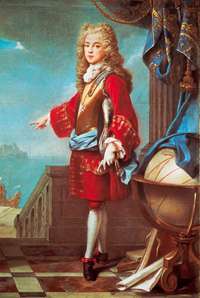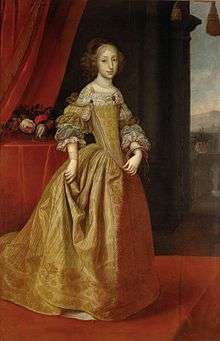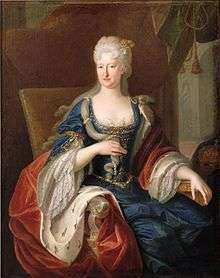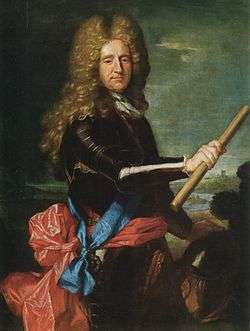Treaty of The Hague (1698)
| First Treaty of Partition between Great Britain,[lower-alpha 1] France and the United Provinces | |
|---|---|
 Joseph Ferdinand of Bavaria, heir to the Spanish throne (1692-1699) | |
| Context | Issues that resulted in the War of the Spanish Succession |
| Signed | 11 October 1698 |
| Location | The Hague |
| Parties | |
The 1698 Treaty of The Hague, also known as the 1698 Treaty of Den Haag or First Partition Treaty was the first of two attempts by France, Britain [lower-alpha 3] and the Dutch Republic to achieve a diplomatic solution to the issues that led to the 1701-1714 War of the Spanish Succession.
The Treaty was signed on 11 October 1698, the main provision being the nomination of six year old Joseph Ferdinand of Bavaria as heir to the Spanish throne. When he died in February 1699, it was replaced by the Second Partition Treaty or Treaty of London of March, 1700.
Background

In 1665, Charles II became the last Habsburg King of Spain; he suffered from ill-health most of his life and by 1697 it seemed likely he would die childless. Although Spain's financial and military power declined during the 17th century, it remained powerful and largely intact, with territories in Italy, the Spanish Netherlands, the Philippines, and large areas of the Americas.[1] Since the closest heirs were from the ruling Austrian Hapsburg and French Bourbon families, the succession was of great significance to the European balance of power and a matter of debate for many years.[lower-alpha 4]
From 1665 onwards, Louis XIV fought a series of wars to establish defensible borders and establish French military supremacy in Europe. The most recent was the 1688-1697 Nine Years' War where France had been opposed by the Grand Alliance, a coalition that included England, the Dutch Republic, and Austria. The 1697 Treaty of Ryswick that ended it was the result of mutual exhaustion but also the acceptance by Louis he could not achieve his objectives without support. Although Charles survived far longer than anyone expected, by 1697 his health was in terminal decline; in the event of a war over the Succession, France needed allies.
Louis' concern was increased by Austrian victories over the Ottoman Empire, and resulting conquest of Hungary and Transylvania. The resulting growth in Hapsburg power and confidence meant Emperor Leopold I initially refused to sign the Treaty of Ryswick as it left the succession unresolved. He did so in October 1697, but many viewed it as only a pause in hostilities.[2]
Negotiations

Unlike Austria and France, the Crown of Spain could be inherited through the female line, enabling Charles' two sisters to pass their rights onto their children. Each had one surviving child; his half sister Maria Theresa (1638-83) married Louis XIV and had a son, Louis, le Grand Dauphin. His full sister Margaret Theresa (1651-1673) married Emperor Leopold; their daughter Maria Antonia (1669-1692) married Maximillian Emanuel, Elector of Bavaria and they had one surviving son, Joseph Ferdinand.

The Spanish political establishment was split between pro-Austrian and pro-French factions; for most of Charles' reign, government was controlled by the 'Austrians' led by his mother Mariana of Austria. After her death in 1696, this role was assumed by his wife Maria Anna whose elder sister Eleonore was Emperor Leopold's third wife.[3]
When Charles fell seriously ill in 1698, the dominance of the Austrian faction made co-operation with Britain an attractive option for Louis. William III was a significant figure in Europe due to his military leadership of the Grand Alliance during the Nine Years War and dual role as King of England and Stadtholder of the Dutch Republic.[4] His involvement recognised the Succession was not only a dynastic dispute between Hapsburgs and Bourbons but an issue affecting the security of England and the Dutch Republic.[5]
William was concerned at the vulnerability of the Dutch Republic to French invasion; the French army remained on a war footing but the 1698 English General Election returned a Parliament determined to cut military expenditure as quickly as possible. By 1699, the British army numbered less than 7,000, [lower-alpha 5] making a diplomatic solution essential; the Partition Treaties also provided an opportunity to build on the Treaty of Ryswick to create a lasting peace.[6] He and Louis felt Ryswick was unnecessarily delayed by diplomatic minutiae, talks starting in 1694 but only completed in 1697 after the two negotiated direct and they placed great faith in a similar process to prevent war over the Succession.[7]
Initial discussions were held in Paris between the Earl of Portland and the Marquis de Pomponne, followed by more substantive talks at The Hague beginning in May with Anthonie Heinsius, Grand Pensionary of Holland and the French diplomat Count Tallard. The Treaty was signed by France, Britain and the Dutch Republic on 11 October 1698.
Key Provisions

%2C_by_follower_of_Claude_Lefebvre.jpg)
Louis XIV first proposed his son Le Grand Dauphin as Charles' successor but this was rejected and the parties compromised by selecting Joseph Ferdinand of Bavaria.[8] This was supported by Charles' wife, Queen Maria Anna who was related by marriage to Leopold but also a Wittelsbach, the senior member being Max Emmanuel of Bavaria, Joseph Ferdinand's father. While Leopold's grandson would become King of Spain, it would also increase the power and status of the Wittelsbachs, a long-standing Hapsburg rival.
The provisions of the Treaty made Joseph Ferdinand heir to the bulk of the Spanish Monarchy, which included the Spanish Netherlands currently governed by Max Emmanuel as Spanish Viceroy. France was allocated the Kingdoms of Naples and Sicily and other concessions in Italy plus the modern Basque province of Gipuzkoa. Finally, Leopold's younger son Archduke Charles became ruler of the Duchy of Milan, a possession considered vital to the security of Austria's southern border.[9]
The negotiations were conducted in secret and while this was normal practice for the absolutist regime of Louis XIV, it was no longer the case in Britain. Even Lord Somers, Lord Chancellor and senior English legal officer, only learned the terms of the Treaty shortly before it was signed on 11 October; his reaction was unfavourable but since it had been agreed, he could see no means of undoing it.[10]
Aftermath
When the Spanish learned of the agreement, they developed their own solution to ensure Spain's independence from both France and Austria and prevent their Empire being divided. On 14 November 1698, Charles II published his will, making Joseph Ferdinand heir to an independent and undivided Spanish Monarchy with Maria Anna as Queen Regent during his minority, an announcement allegedly received by his Spanish councillors in silence.[11]
In February 1699, Joseph Ferdinand died of smallpox, a common disease of the period despite the accusations of poison that often accompanied the death of significant people. Whether he would have become King had he survived is open to question since few seemed keen on the Treaty. The level of mutual mistrust between the English and French in particular made their ability to enforce it questionable, one suggestion being that Louis saw it as a delaying tactic to provide time to build Spanish support for a French candidate.[12] However, the three parties involved began negotiating the Second Partition Treaty, also known as the Treaty of London.
Footnotes
- ↑ Until 1707, England and Scotland were separate countries under one monarch ie William but Treaties were signed by the King of Great Britain.
- ↑ As above; the Union Jack or King's Colour is used here for ease of convenience.
- ↑ Until 1707, England and Scotland were separate countries but Treaties were signed by William III as King of Great Britain.
- ↑ For example, it was referenced in the 1670 Secret Treaty of Dover between England and France, the 1689 Grand Alliance etc.
- ↑ Another 12,000 were based in Ireland and paid for by the Irish Parliament.
References
- ↑ Storrs, Christopher (2006). The Resilience of the Spanish Monarchy 1665-1700. OUP Oxford. pp. 6–7. ISBN 0199246378.
- ↑ Meerts, Paul Willem (2014). Diplomatic negotiation: Essence and Evolution (dissertation). http://hdl.handle.net/1887/29596: Leiden University. p. 168.
- ↑ Ward, William,, Leathes, Stanley (1912). The Cambridge Modern History (2010 ed.). Nabu. p. 381. ISBN 1174382058.
- ↑ Jones, JR (1980). Britain and the World, 1649-1815. Fontana Press. p. 157. ISBN 0006337589.
- ↑ Rule, John, Trotter, Ben (2014). A World of Paper: Louis XIV, Colbert de Torcy, and the Rise of the Information State. McGill-Queen's University Press. pp. 94 passim. ISBN 0773543708.
- ↑ Rommelse, Gijs (2011). Ideology and Foreign Policy in Early Modern Europe (1650–1750). Routledge. p. 303. ISBN 1409419134.
- ↑ Onnekink, David (ed) Mijers, Esther (ed), Rule, John (2017). The Partition Treaties, 1698-1700; A European View in Redefining William III: The Impact of the King-Stadholder in International Context. Routledge. pp. 91–108. ISBN 1138257966.
- ↑ Onnekink, David (2007). The Anglo-Dutch Favourite: The Career of Hans Willem Bentinck, 1st Earl of Portland (1649–1709). Routledge. p. 201. ISBN 1138259314.
- ↑ Ward, William,, Leathes, Stanley (1912). The Cambridge Modern History (2010 ed.). Nabu. p. 384. ISBN 1174382058.
- ↑ Sachse, William Lewis (1986). Lord Somers: A political portrait. Manchester University Press. p. 148. ISBN 071900604X.
- ↑ Ward, William,, Leathes, Stanley (1912). The Cambridge Modern History (2010 ed.). Nabu. p. 385. ISBN 1174382058.
- ↑ Ward, William,, Leathes, Stanley (1912). The Cambridge Modern History (2010 ed.). Nabu. p. 383. ISBN 1174382058.
Sources
- Hargreaves-Mawdsley, HN; Eighteenth-Century Spain 1700-1788: A Political, Diplomatic and Institutional History (Macmillan, 1979);
- Mckay, Derek and Scott, HM (ed); The Rise of the Great Powers 1648 - 1815 (The Modern European State System) (Routledge, 1983);
- Jones, JR; Britain and the World, 1649-1815 (Fontana Press, 1980);
- Onnekink, David; The Anglo-Dutch Favourite: The Career of Hans Willem Bentinck, 1st Earl of Portland (1649–1709) (Routledge, 2006);
- Rommelse, Gijs; Ideology and Foreign Policy in Early Modern Europe (1650–1750) (Routledge, 2011);
- Rule, John and Trotter, Ben; A World of Paper: Louis XIV, Colbert de Torcy, and the Rise of the Information State; (McGill-Queen's University Press, 2014);
- Sachse, William Lewis; Lord Somers: A political portrait; (Manchester University Press, 1986);
- Storrs, Christopher; The Resilience of the Spanish Monarchy 1665-1700 (OUP Oxford, 2006);
- Ward, William,, Leathes, Stanley (1912); The Cambridge Modern History (Nabu Press, 2010 ed.)
See also
- Grand Alliance
- Treaty of London (1700), the Second Partition Treaty
- List of treaties
- War of the Spanish Succession